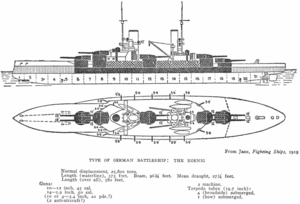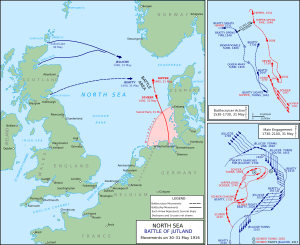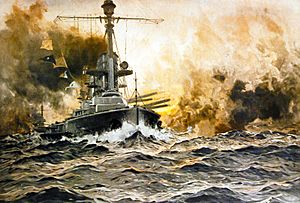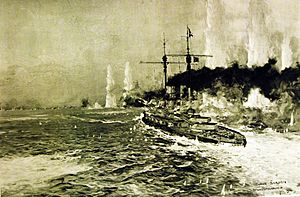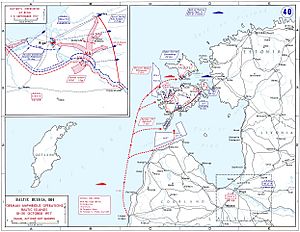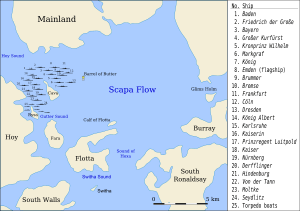SMS Markgraf facts for kids
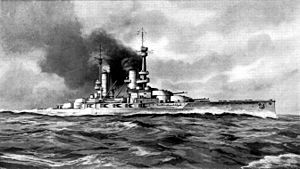
Recognition drawing of a König-class battleship
|
|
Quick facts for kids General characteristics |
|
|---|---|
| Class and type | König-class battleship |
| Displacement | |
| Length | 175.4 m (575 ft 6 in) |
| Beam | 29.5 m (96 ft 9 in) |
| Draft | 9.19 m (30 ft 2 in) |
| Installed power |
|
| Propulsion |
|
| Speed | 21 knots (39 km/h; 24 mph) |
| Range | 8,000 nmi (15,000 km; 9,200 mi) at 12 knots (22 km/h; 14 mph) |
| Complement |
|
| Armament |
|
| Armor |
|
SMS Markgraf was a powerful battleship that served in the Imperial German Navy during World War I. She was the third ship of the four-ship König class class. Markgraf was built in Germany, starting in November 1911, and was launched into the water on June 4, 1913. She officially joined the German Navy on October 1, 1914, just a couple of months after the war began in Europe.
The ship was named in honor of the royal family of Baden. The name Markgraf is a German noble title, similar to a Margrave or Marquess in English. Markgraf was armed with ten large 30.5 cm (12 inch) guns, placed in five turrets, and could travel at a top speed of 21 knots (39 km/h; 24 mph).
Along with her three sister ships—König, Grosser Kurfürst, and Kronprinz—Markgraf took part in many important naval battles during the war. This included the huge Battle of Jutland on May 31 and June 1, 1916. At Jutland, Markgraf was in the main German battle line and faced heavy attacks from the British Grand Fleet. She was hit five times by large shells and 23 of her crew were injured or killed.
Markgraf also helped in Operation Albion in late 1917. This was a mission to conquer islands in the Gulf of Riga. After this successful operation, the ship was damaged by a mine on her way back to Germany.
After Germany lost the war and signed the Armistice in November 1918, Markgraf and most of the other large German warships were taken by the British Royal Navy to Scapa Flow. This was a large bay in Scotland. The ships had their weapons removed and only small crews remained on board. This happened while the Allied powers discussed the final peace agreement, the Treaty of Versailles.
On June 21, 1919, just days before the treaty was signed, the German commander, Rear Admiral Ludwig von Reuter, gave a secret order. He told his fleet to sink their own ships. This was to stop the British from taking control of them. Unlike most of the other ships that were sunk, Markgraf was never brought back up from the water. Her wreck still lies at the bottom of Scapa Flow today.
Contents
Building a Battleship: The König Class
The four König-class battleships were built because of a naval competition between Britain and Germany. They were Germany's fourth group of modern battleships, called dreadnoughts. These ships were designed to be better than the British Orion-class battleships. The König class improved on earlier German designs, especially by placing their main guns in a more effective way.
Markgraf was a very large ship. When first built, she weighed about 25,796 metric tons (25,389 long tons). When fully loaded, she weighed 28,600 metric tons (28,100 long tons). She was 175.4 meters (575 feet 6 inches) long, 29.5 meters (96 feet 9 inches) wide, and sat 9.19 meters (30 feet 2 inches) deep in the water.
The ship was powered by three steam turbines. These turbines got their steam from three oil-fired and twelve coal-fired boilers. This powerful system produced about 30,450 kilowatts (40,830 horsepower) and allowed the ship to reach a top speed of 21 knots (39 km/h; 24 mph). Markgraf could travel about 8,000 nautical miles (15,000 km; 9,200 mi) at a slower speed of 12 knots (22 km/h; 14 mph). Her crew included 41 officers and 1,095 enlisted men.
What Weapons Did Markgraf Have?
Markgraf was armed with ten 30.5 cm (12 inch) guns. These were placed in five twin gun turrets. Two turrets were at the front, two at the back, and one in the middle of the ship. This arrangement allowed more guns to fire at a target.
For smaller targets, she had fourteen 15 cm (5.9 inch) quick-firing guns and six 8.8 cm (3.5 inch) quick-firing guns. These were mounted in protected areas called casemates. Like other large warships of that time, she also had five 50 cm (20 inch) torpedo tubes under the water. One was in the front, and two were on each side. Later, her 8.8 cm guns were replaced with four 8.8 cm anti-aircraft guns to shoot down planes.
How Was Markgraf Protected?
The ship's main protection was a thick armored belt made of strong steel. This belt was 35 cm (14 inches) thick in the middle, where the engines and ammunition storage were. It was thinner at the front (18 cm or 7.1 inches) and back (12 cm or 4.7 inches).
The main deck was 10 cm (3.9 inches) thick in the middle and 4 cm (1.6 inches) at the front and back. The main gun turrets had 30 cm (12 inches) of armor on their sides and 11 cm (4.3 inches) on their roofs. The casemate guns had 15 cm (5.9 inches) of armor. The command center, called the conning tower, also had 30 cm (12 inches) thick sides.
Markgraf's Time at Sea
Markgraf was built at the AG Weser shipyard in Bremen. Her keel, the first part of the ship, was laid down in November 1911. She was launched on June 4, 1913, and officially joined the High Seas Fleet on October 1, 1914. After joining, she went through sea trials, which are tests to make sure everything works correctly. These lasted until December 12. By January 10, 1915, Markgraf joined her three sister ships in the III Battle Squadron.
In early 1915, the III Squadron went to the Baltic Sea for training. They practiced maneuvers, gunnery, and torpedo attacks. They returned to the North Sea in February, but it was too late to help other German ships in the Battle of Dogger Bank.
After the Battle of Dogger Bank, Admiral Hugo von Pohl became the new commander of the fleet. He led several operations into the North Sea in 1915, but Markgraf and the fleet did not encounter any British warships during these trips.
In January 1916, Vice Admiral Reinhard Scheer took over as fleet commander. He wanted to be more aggressive and force a big battle with the British Grand Fleet. The first of his operations was in March, but it was uneventful. In April, German battlecruisers attacked the English coast. Markgraf and the rest of the fleet sailed in support. One battlecruiser, Seydlitz, hit a mine and had to leave. The others attacked Lowestoft, but then British ships appeared. Scheer, warned that the Grand Fleet was coming, decided to retreat to safer German waters.
The Battle of Jutland (1916)
Markgraf played a big part in the Battle of Jutland, which happened on May 31 and June 1, 1916. The German fleet hoped to lure out and destroy a part of the British Grand Fleet before the main British force could arrive. Markgraf was the third ship in the German battle line, sailing behind her sisters König and Grosser Kurfürst. These four ships were at the very front of the German fleet.
The battle began when German battlecruisers met British battlecruisers. Soon, two British battlecruisers were destroyed. The German ships then tried to draw the British towards the main German fleet. At 5:45 PM, the order was given to open fire.
Markgraf began firing her main guns at the British battlecruiser Tiger. She also used her smaller guns to shoot at British destroyers trying to launch torpedoes. Markgraf kept firing at Tiger until the faster British ships moved out of range. During this time, two British battleships, Warspite and Valiant, fired at the leading German battleships. At 6:10 PM, Markgraf was hit by a large 15-inch (38 cm) shell. This shell hit a weak spot in her armor, causing a hole and letting about 400 metric tons (390 long tons) of water into the ship. Two other shells hit her but did not explode, causing little damage.
Later, a German cruiser was disabled, and Markgraf and her sisters tried to protect it. British cruisers and armored cruisers then launched a torpedo attack. Markgraf and her sisters fired heavily at them. Markgraf fired at the armored cruiser Defence, which exploded and sank. While another German ship is usually given credit, Markgraf's gunners also claimed to have sunk it.
Markgraf then fired at the battlecruiser Princess Royal and hit her twice. One hit disabled a gun turret and caused serious damage to the upper deck, killing one crew member and injuring others. The second shell caused more damage and injuries. At the same time, Markgraf's smaller guns severely damaged the cruiser Warrior, forcing her to withdraw. Warrior sank the next morning on her way back to port.
Around 7:30 PM, the main British battleship force arrived. Markgraf was hit again by a 13.5-inch (34 cm) shell. This shell hit her armor but did not go through. However, it holed the armor and disabled one of her 15 cm guns, killing the gun crew. Around the same time, her port engine had to be turned off because of a damaged propeller shaft. This slowed her down to 17 or 18 knots (31 or 33 km/h; 20 or 21 mph).
After 8:00 PM, Markgraf engaged British light cruisers. She was also hit by a 12-inch (30 cm) shell, but it did not explode and caused only minor damage. The heavy British fire forced the German fleet to turn away. Because Markgraf was slower, she turned early to stay in line. This caused some confusion in the German formation.
Later that night, British destroyers attacked the German line. Markgraf held her fire at first, unsure if they were friendly. But other German ships identified them as hostile and opened fire, forcing the British destroyers to retreat.
The German fleet managed to get through the British forces and reached German waters by 4:00 AM on June 1. Markgraf went to Hamburg for repairs in a large floating dock. The repairs were finished by July 20. During the battle, Markgraf fired 254 main gun shells and 214 smaller shells. She was hit by five large shells, which killed 11 men and wounded 13.
After Jutland: More Operations
After her repairs in July 1916, Markgraf went to the Baltic Sea for more tests. She then joined a fleet operation on August 18–19. The British knew about the German plans and sent their Grand Fleet to meet them. The German commander, Scheer, decided not to risk another big battle so soon after Jutland, so he turned his ships around and returned to port.
Markgraf was part of another uneventful trip towards Sunderland in October. She also participated in training exercises. In November, two German submarines got stuck on the Danish coast. Markgraf and her squadron were sent to cover the rescue. During this operation, a British submarine torpedoed two of Markgraf's sister ships, Grosser Kurfürst and Kronprinz, causing moderate damage. For most of 1917, Markgraf was on guard duty in the North Sea, with breaks for maintenance and training.
Operation Albion (1917)
In September 1917, after capturing the Russian port of Riga, the German navy decided to clear out Russian naval forces from the Gulf of Riga. They planned to capture the Baltic island of Ösel and its Russian gun batteries. On September 18, the order was given for a joint operation with the army to take Ösel and Moon Islands. The main naval force included the flagship Moltke, along with the III and IV Battle Squadrons. The III Squadron had the four König-class ships, plus the new battleship Bayern. The entire force was huge, with about 300 ships, over 100 aircraft, and six zeppelins.
The operation started on October 12. Moltke and the four König-class ships helped land ground troops by firing at shore batteries. Markgraf specifically fired at a battery on Cape Ninnast. After the successful landing, Markgraf stayed behind for a few days before rejoining her squadron. On October 18, she briefly ran aground but was quickly freed. She then helped bombard Russian positions on the island of Kynö on October 25. Two days later, she left Operation Albion to return to the North Sea.
On her way back, Markgraf hit two mines in the Irben Strait and took on about 260 metric tons (260 long tons) of water. She continued to Wilhelmshaven, where the mine damage was repaired from November 6 to 23. After repairs, Markgraf went back to guard duty in the North Sea. She missed a planned raid in April 1918 because she was in dock getting a new foremast installed.
Markgraf's Final Days
Markgraf and her three sister ships were supposed to take part in a final fleet action at the end of October 1918, just before the Armistice was to begin. The German fleet commander, Grand Admiral Scheer, wanted to cause as much damage as possible to the British navy to get a better deal for Germany in the peace talks. However, many sailors were tired of the war and felt this operation would stop the peace process.
On the morning of October 29, 1918, the order was given to sail the next day. But that night, sailors on several battleships, including Markgraf, refused to obey orders. This unrest, known as a mutiny, forced the admirals to cancel the operation. The Kaiser, Germany's emperor, was told about the situation and famously said, "I no longer have a navy."
Scuttling at Scapa Flow
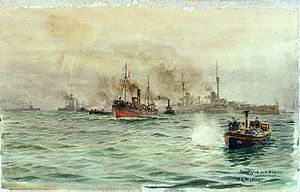
After Germany surrendered in November 1918, most of the German High Seas Fleet, led by Rear Admiral Ludwig von Reuter, was taken to the British naval base in Scapa Flow. Before they left, Admiral Adolf von Trotha made it clear to von Reuter that he must not let the Allies take control of the ships. The German fleet was met by British ships that escorted them to Scapa Flow. Once there, the German ships had their guns disabled, and their crews were reduced to only 200 men.
The fleet remained at Scapa Flow during the peace talks that led to the Treaty of Versailles. Von Reuter believed that the British planned to seize the German ships on June 21, 1919. He didn't know that the deadline for signing the peace treaty had been extended. So, on the morning of June 21, when the British fleet left Scapa Flow for training, Reuter gave the order to sink the ships.
Markgraf sank at 4:45 PM. British guards tried to stop the Germans, but they panicked. They shot and killed Markgraf's captain, Walter Schumann, who was in a lifeboat, and one enlisted man. In total, nine Germans were killed and twenty-one were wounded. The remaining German crews, about 1,860 men, were taken prisoner.
Markgraf was never brought up from the water for scrap, unlike most of the other large ships that were sunk. Markgraf and her two sisters sank in deeper water, making it harder to salvage them. World War II started in 1939, stopping all salvage operations. After the war, it was decided that raising these deeper wrecks was too expensive.
The rights to salvage these wrecks were sold to Britain in 1962. Because the steel in their hulls was made before nuclear weapons existed, Markgraf and her sisters are a rare source of "low-background steel." This special steel is sometimes used in scientific equipment.
Today, Markgraf and the other wrecks at the bottom of Scapa Flow are popular dive sites. There is a rule that divers cannot take items from the wrecks. In 2017, marine archaeologists studied Markgraf and nine other wrecks in the area. They used sonar and underwater robots to map the wrecks and see how they are decaying.
At one point, the wreck of Markgraf was owned by a company called Scapa Flow Salvage. They sold the rights to a diving contractor named Tommy Clark in 1981. In 2019, Clark listed the wreck for sale on eBay for £250,000. Three other wrecks he owned were also for sale. Markgraf and her two sister ships were eventually sold for £25,500 each to a company from the Middle East.
Images for kids
-
Painting of Markgraf entering the Firth of Forth
See also
 In Spanish: SMS Markgraf para niños
In Spanish: SMS Markgraf para niños


